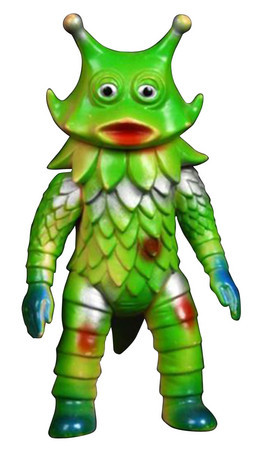Japanese toys command monster attention

One of the newer collectibles to be found at auctions is Japanese monster toys made in the 1960s and 1970s. A recent auction by Morphy of Denver, Pa., was held on land and online to sell a huge of collection of toys, including about 50 of the Japanese kaiju (“strange beast”) toys.
These toys sell by the millions in Japan to boys, girls and adults. They are based on old monster movies and TV shows. Bullmark (1969-1977), a Japanese company, was the most famous manufacturer of these toys. The soft-vinyl toys were made in the early 1970s. The toys were made in sizes from 3 inches to more than 12 inches. Some were repainted to sell in Hawaii, and these brightly colored versions are rare and desirable. Later, in the 1970s, some monster toys came with metal parts, and still later some were die-cast.
Watch some old “creature features” to learn about the monsters. The toys have been “invading” the United States, and their popularity and prices are rising.
Q: My roll-top desk has a metal plaque on the inside that reads “Boston Derby Desk.” I bought it from a retired Cleveland banker after World War II. What can you tell me about its manufacturer, age and value?
A: George H. Derby opened a small furniture company in Boston in 1872. By 1879 he was producing roll-top desks. A partner joined him the following year, and his business became Derby and Kilmer Desk Co., then Derby, Kilmer and Pond Desk Co.
In the mid-1890s, the firm was incorporated as the Derby Desk Co. Its headquarters were in Boston, but it had a large factory in Somerville, Mass., just outside of Boston. The company expanded across the country until it was bought by another firm in 1931.
Derby roll-top desks sell for a few hundred dollars into the low thousands, depending on style and condition.
Q: While we were at the National Pike Festival in Maryland last May, my son found a blackened metal tray in a box of junk. Please help us identify it. It’s 10 by 14 inches, with a twisted edge. We cleaned it and found it has a mirrorlike silvery surface. The marks on the bottom include “Farmers Bldg. Rest.” and “GM Co., EP” surrounding an anchor within a shield.
A: Your tray is silver plate and was made by the Gorham Manufacturing Co. (GM Co.) of Providence, R.I. The “EP” mark indicates that the tray is electroplated. Gorham must have made it to order for a restaurant (Farmers Building Restaurant?).
The anchor-in-shield mark was one of several that Gorham used on its silver-plated pieces. Gorham’s corporate name was Gorham Manufacturing Co. from 1865 to 1961, when it became Gorham Corp.
Q: My grandmother left me her triangular fabric handkerchief holder. I know it predates the 1950s, but I don’t know by how much. It’s decorated in the corners and across the top with complex flower shapes made out of ribbon. Does that help you date it?
A: The flowers are “ribbonwork,” a women’s craft that was popular in the United States from about 1900 through the 1920s. That doesn’t mean some women weren’t doing it later. Ribbonwork also is called “ribbon craft” or “ribbonry.” It involves folding fabric ribbon into floral or other shapes and placing them on something else — a dress, coat, jacket, hat or even a handkerchief holder.
Q: I found an old political campaign button with the photos of two candidates identified as “McKinley” and “Clough.” I know Clough was the governor of Minnesota at the time McKinley first ran for president in 1896, but why is Clough on the button? Was he making a bid to be the vice-presidential nominee? The edge of the 7/8-inch button is marked “National Game and Novelty Co., St. Paul, Minn.” There are also two dates, 1894 and 1896. Any ideas about why this button was created and what it might be worth?
A: Political buttons that picture two candidates are called “jugates.” Your jugate is what collectors of political items call a “coattail” button — one that promotes a local candidate by linking him or her with a more famous national candidate.
David Marston Clough (1846-1924) was running for re-election as governor of Minnesota in 1896, the same year William McKinley (1943-1901) was running for his first term as president.
Coattail buttons are still common today. Your button sells for $15-$20.
Q: We own a carved wooden armchair that has been in our family for years. The top third of the chair back is decorated with a carving of a gargoyle face. The paper label on the bottom says, “August Hausske & Co., Weed Street, Chicago, Ill.”
A: You have a “North Wind chair,” a style that was popular during the late Victorian era (1880-1900) into the early 20th century. The face, from folklore, was supposed to blow evil spirits away.
August Hausske was involved with the Northwestern Parlor Suite Manufacturing Co. before he opened his own firm in 1880. In 1891, Hausske’s parlor furniture was displayed at the Chicago Furniture Exposition. August Hausske & Co. was still in business in Chicago in the 1920s, but moved to Peru, Ind., in the 1930s or ’40s.
Depending on the condition of your chair, it could sell for up to $500.
Tip: A good way to remove rings and stains from a white marble top is to mix TSP (trisodium phosphate, found in paint and hardware stores), water and scouring powder. Rub on the spots. Too much rubbing may remove some of the polish, so be careful.
Terry Kovel’s column is syndicated by King Features. Write to: Kovels, (Las Vegas Review-Journal), King Features Syndicate, 300 W. 57th St., New York, NY 10019.